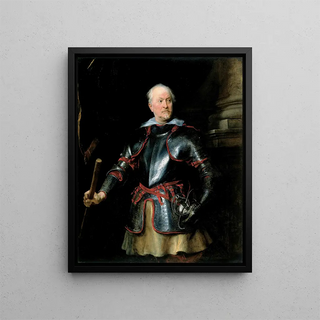Painting Portrait of a Man in Armor - Antoine van Dyck | Art print


View from behind

Frame (optional)
Portrait of a Man in Armor - Antoine van Dyck – Captivating Introduction
The "Portrait of a Man in Armor" by Antoine van Dyck is an iconic artwork that embodies not only the artistic genius of its creator but also the very essence of Baroque portraiture. This painting, which immediately captures the viewer's attention, evokes an atmosphere of mystery and nobility. Through this piece, Van Dyck manages to capture the soul of his subject while highlighting the codes of high society of his time. The strength of this portrait lies in how it merges the realism of the face with theatrical staging, creating a profound emotional connection with the viewer.
Style and uniqueness of the work
Van Dyck's style is characterized by exceptional finesse and meticulous attention to detail. In "Portrait of a Man in Armor," each brushstroke seems charged with intention, revealing the texture of the armor while maintaining a fluidity that animates the painting. The play of light and shadow, typical of the Baroque, emphasizes the facial features and enhances the character's expression, which appears both proud and contemplative. This duality is reinforced by the choice of colors, where dark tones of the armor contrast with the clarity of the model's complexion. The work does not merely depict a man in armor; it tells a story, that of an individual whose gaze seems to transcend time, inviting the viewer to question his identity and status.
The artist and his influence
Antoine van Dyck, a pupil of Rubens, established himself as one of the greatest portraitists of the 17th century. His influence on portrait art is undeniable, marking a transition toward a more psychological and introspective approach to human representation. Van Dyck skillfully integrated elements of Flemish painting while developing a personal style that has inspired many artists through the centuries. His ability to capture the personality of his subjects made him a preferred choice for European nobility, and his impact is still felt today in the way portraits are conceived. Through his works, he redefined the standards of

Matte finish

View from behind

Frame (optional)
Portrait of a Man in Armor - Antoine van Dyck – Captivating Introduction
The "Portrait of a Man in Armor" by Antoine van Dyck is an iconic artwork that embodies not only the artistic genius of its creator but also the very essence of Baroque portraiture. This painting, which immediately captures the viewer's attention, evokes an atmosphere of mystery and nobility. Through this piece, Van Dyck manages to capture the soul of his subject while highlighting the codes of high society of his time. The strength of this portrait lies in how it merges the realism of the face with theatrical staging, creating a profound emotional connection with the viewer.
Style and uniqueness of the work
Van Dyck's style is characterized by exceptional finesse and meticulous attention to detail. In "Portrait of a Man in Armor," each brushstroke seems charged with intention, revealing the texture of the armor while maintaining a fluidity that animates the painting. The play of light and shadow, typical of the Baroque, emphasizes the facial features and enhances the character's expression, which appears both proud and contemplative. This duality is reinforced by the choice of colors, where dark tones of the armor contrast with the clarity of the model's complexion. The work does not merely depict a man in armor; it tells a story, that of an individual whose gaze seems to transcend time, inviting the viewer to question his identity and status.
The artist and his influence
Antoine van Dyck, a pupil of Rubens, established himself as one of the greatest portraitists of the 17th century. His influence on portrait art is undeniable, marking a transition toward a more psychological and introspective approach to human representation. Van Dyck skillfully integrated elements of Flemish painting while developing a personal style that has inspired many artists through the centuries. His ability to capture the personality of his subjects made him a preferred choice for European nobility, and his impact is still felt today in the way portraits are conceived. Through his works, he redefined the standards of
12,34 €






